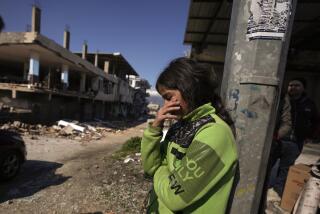Aid groups see ‘dramatic’ increase in donations after death of Syrian toddler
- Share via
The photo told a familiar story of dispossessed refugees from war-torn Syria. But the image of a Syrian toddler’s small, lifeless body on a beach in Turkey -- thrown with his family from a capsized raft -- suddenly made the long-running crisis seem urgent and new.
The photograph of the toddler, later identified as a 3-year-old named Aylan, sparked debate over the international response to the enormous tide of refugees and migrants arriving on Europe’s shores.
Debate, for some, led to action -- multiple aid groups said they noticed a substantial increase in donations since the photos emerged. Christian humanitarian organization World Vision said donations nearly tripled just one day after the photos of Aylan circulated.
On Tuesday, the organization received $3,755 in funds. By Wednesday -- the day the boy was found -- that jumped to about $12,500, records show.
“Our donors clearly have a heart for what is happening,” said Loren Skaggs, the group’s Internet marketing director. “We hope the spirit of compassion continues even after the news stories fade.”
Online donations to Islamic Relief USA, which provides aid to Syrian refugees, also about doubled the average level over the past two days.
A swell of widespread public sentiment usually seems to help make the U.S. and foreign governments more receptive to providing aid or admitting larger numbers of refugees, said Christina Tobias-Nahi, the group’s director of public affairs.
“Those kind of media images always spur an increase in donor interest,” Tobias-Nahi said. “We’re continually doing outreach and advocacy to keep the issue alive.”
Though grateful for the surge in funds, aid organization leaders said they remain wary of focusing too closely on the photos alone.
They stressed that the boy’s death put a human face to the tragedies that have killed more than 2,500 migrants and refugees this year, and tens of thousands more continue their trek.
“It sometimes takes a horrifying image to remind people of the gravity of the reality these people are experiencing, but they’ve been experiencing it every day,” said Abby Safirstein, Save the Children USA’s director of humanitarian funding strategy.
For her group, she said, it is too early to tell whether there was a significant or sustained bump in funds.
Safirstein said she doesn’t attribute the rise in public interest in the plight of Syrian refugees to Aylan’s photo specifically. More likely, she said, it is the overall increase in media attention since the impacts of the refugee crisis have spilled beyond the Middle East and into Europe.
“It’s not just one photo; it’s about the many stories you hear about the tragic journey what many of these families are enduring,” she said.
Gary Shaye, the group’s senior director of board relations and emergency operations, added: “A lot of times you talk in big numbers. This personalizes it ... for people who might not understand the conflict and how children are affected.”
When the image hit the Web around 7 a.m. Eastern time Wednesday, page views at UNICEF spiked more than 149%, according to Jodi Patkin, senior director of public relations for UNICEF’s U.S. Fund. Donations to UNICEF are up 105% since the picture appeared, Patkin said.
But aid groups remain concerned that the number of migrants and refugees in need still exceeds the resources to help them.
“We’re encouraged that the public is taking action,” U.S. Fund for UNICEF President Caryl Stern said in a statement. “But there are currently more children on the move since before World War II, and these children need so much more.”
Follow us on Twitter: @raablauren and @sarahparvini
Times staff writers Laura King and Glen Johnson contributed to this report.
More to Read
Sign up for Essential California
The most important California stories and recommendations in your inbox every morning.
You may occasionally receive promotional content from the Los Angeles Times.












